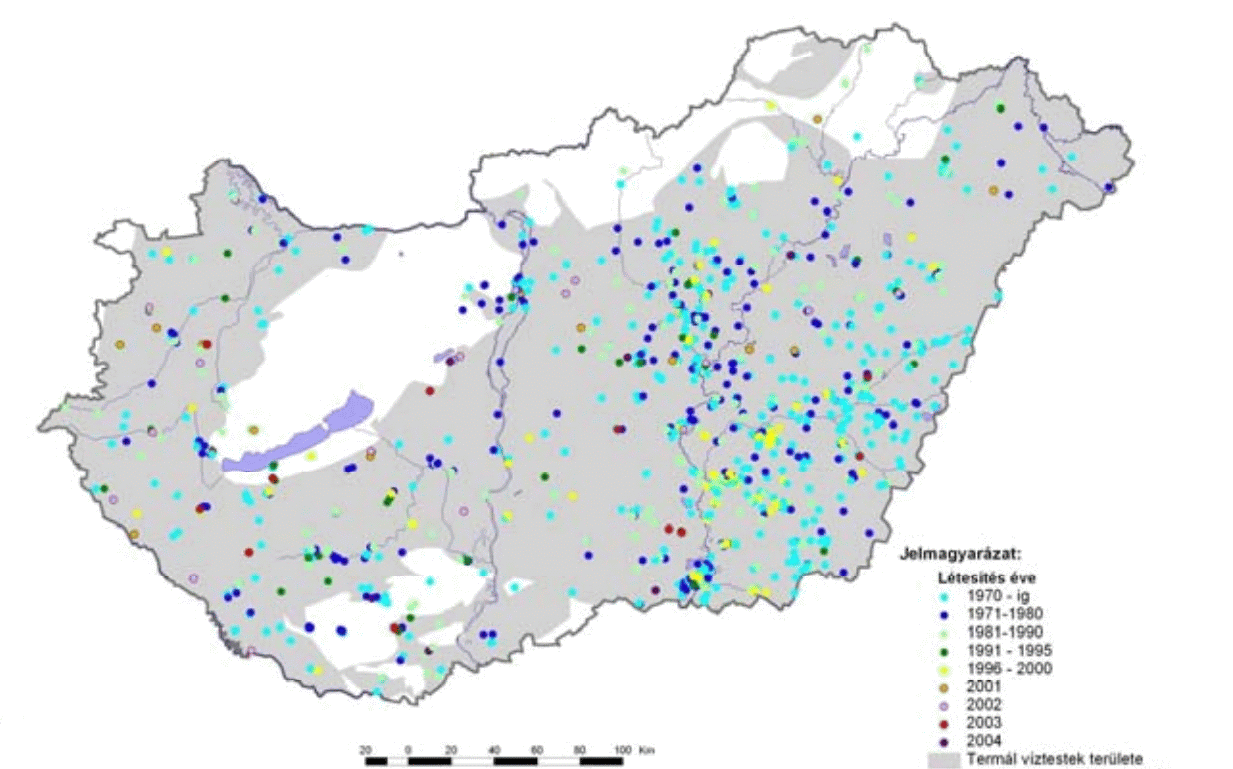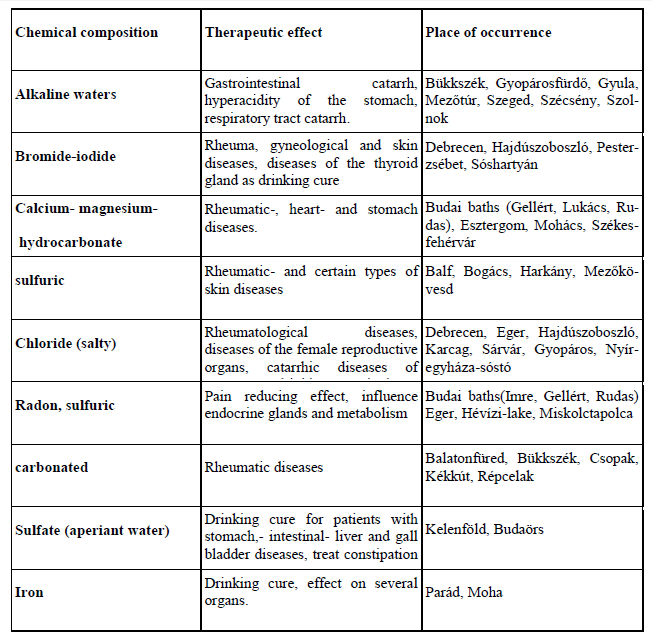Bathing culture after changing Hungary’s borders by the Peace Treaty of Trianon
As one of the consequences of the First World War, Hungary lost a considerable part of its former area and due to this loss Hungarian bathing culture also suffered considerable damage. Hungarian resorts of international fame were now outside of Hungary’s borders The loss of the country’s mineral resources turned the attention of experts to the remaining natural resources, including the country’s hot water springs.
The intensive exploration of hot water springs began in the 1920s: first it was Hajdúszoboszló where hot water springs were found (1925); it was followed by Szeged (1927), Berekfürdő and Szolnok (1928), as well as Eger (1932). At the same time the search for healthy drinking water often led to the exploration of waters of higher temperature, especially in the Great Plain area, where they could not find good water resources near the surface. It was also in this period that the heat of these waters was utilized to give energy. (Lorberer Á. 2010).
In the 1930s it was Ferenc Pávai Vajna (1886-1964) who pioneered the search for hydrocarbons. This research occasionally led to finding new thermal water springs. Examples include among many others the baths of Mezőkövesd, Csokonyavisonta, Bükkszék, Cserkeszőlő, Nagyszénás, Tótkomlós, Túrkeve, Kiskőrös and Kecskemét. A grand-scale development started in Budapest with the aim of turning Hungary’s capital into the leader of modern bathing culture. It is not by accident that the International Spa Association came into being in 1937 in the Gellért Spa and Hotel in Budapest. (OES 2007).
The development in Hungary’s exploration of its thermal waters was given a new impetus in the 1960s. It was in this period that the Hungarian government financially supported the utilization of thermal waters for heating and agricultural purposes. In addition, the individual settlements were also permitted to drill wells and thus they opened local baths and swimming pools (e.g. Gyula, Mórahalom). The Hungarian hotel enterprise, the Danubius Szálloda- és Gyógyüdülő Vállalat started to operate in 1972 and its activities were also based on Hungary’s thermal tourism. The country’s leading hotels today are the legal successors of that tourism enterprise. (OES 2007).
During the last one and a half decade several Hungarian settlements had thermal wells drilled, in order to meet the newly arising needs for balneological therapies and wellness services (Figure 7). „Having recognized the country’s unique endowments and possibilities, the development of health tourism gained new impetus in the post-millenial years. The driving force of this new development is the Health Tourism Sub-project of the Tourism Project within Hungary’s Széchenyi Plan launched in the year of 2000. (OES 2007, p. 18)”. Under the influence of the developments of this project the average length of the tourist season, as well as the size of the water surface of the pools increased by one and a half times.

Figure 7: The opening years of thermal wells. Source: OES 2007
The number of registered thermal wells recently exceeds 1,000. About 50% of them has water with temperature lower than 40oC, one quarter of wells supplies water with temperature over 60o C. The number of wells supplying water with 90o C is about 4%. For further details see
http://www.kvvm.hu/szakmai/karmentes/kiadvanyok/fav/tvkm/tvkm04.htm
The VITUKI Hydrological Institute has a list of Hungary’s thermal wells. (National Thermal Well Cataster). For further details see:
http://fava.hu/publikaciok/jubileumi_kiadvanyok/tanulmanyok_pdf/lorberer_heviz.pdf
By the register of The National Directorate for Spas and Medicinal Baths (OGYFI) there are 220 settlements in Hungary with thermal water that qualify as medicinal water. (Kátay Á. 2010). In the year 2007 the number of operating medicinal and thermal baths was 187. (OES 2007). The therapeutic utilization of Hungary’s medicinal waters is dependent on their chemical composition. (Table 1)
Table 1: The typical chemical composition of medicinal waters, their therapeutic effects and their places of occurrence in Hungary. Source: people.inf.elte.hu

For further details see: Fürdők - gyógyfürdők Magyarországon (helység, gyógyvíz összetétele, gyógyhatása, fürdőszolgáltatások, fürdő elérhetősége) http://vizterapia.bioenergetikus.hu/
Today the thermal waters and the medicinal waters in Hungary are used not only in therapies but they are also utilized in recreational and wellness programmes, which aim at preventing diseases. Considering the fact that the majority of hotels in our medicinal baths function as wellness hotels, too, the new trend of medical-wellness could easily develop and gain significance.
By Michalkó G. (2011) if a Hungarian tourist wants to spend a long weekend and regenerate in nice surroundings, 18.2% would choose Hévíz and 17.1% Hajdúszoboszló. The other resorts would be far behind them, because the market is very competitive and the interest of tourists in less known spas is considerably lower. The spas of Miskolctapolca (6,3%), Zalakaros (5.3%), Harkány (3.7%), Gyula (3.5%) and Bük (3.2%) are relatively interesting for tourists, but in case of Mezőkövesd (2%), Sárvár (1.7%), Budapest-Gellért-fürdő (1.6%), Budapest-Széchenyi-fürdő (1.5%), Kehidakustány (1.4%), Pápa 1.2%), Kiskunmajsa (1.1%), Orosháza-Gyopárosfürdő (1.0%), when summarizing the demand and quality indicators, it can be concluded, that the preferences of Hungarian tourists are undeservedly low. (Michalkó G. 2011, p. 259)”.
Several of Hungary’s spas await guests with creatively designed aquaparks and adventure baths, all of which serve several generations of guests. These water complexes today can be found all over Hungary, including Kristályfürdő, Ajka; Aquapolis, Szeged; Aquapalace, Hajdúszoboszló; Kecskemét, Élményfürdő és csúszdapark; Aquaworld, Budapest.
51 Hungarian settlements can boast baths with excellent qualifications. The number of internationally favoured medicinal and thermal baths is 17. The spas of Western Transdanubia, Central Hungary and, of course, the baths of Budapest, the capital are the most attractive. In the Great Plain area of Hungary it is Hajdúszoboszló, Gyula and Szeged, which are the most popular destinations with health and wellness tourists. (Albel A. 2012).
The medicinal mud used in physiotherapeutic treatments can only be found at a few places in Hungary. Its production and utilization for medical pruposes are related to spa activities in Hévíz, Hajdúszoboszló and Harkány, while in Makó, Tiszasüly and Alsópáhok its utilization is independent of bath treatments. The therapeutic effect of medicinal mud varies. The medicinal mud of Hévíz, for example, stimulates metabolism and the endocrine glands, the medicinal mud of Hajdúszoboszló is used to treat problems of the lesser pelvis and infertility; the mud from the Maros River reduces pain and improves locomotor conditions, the mud of Kolop (Tiszasüly) is good for sports injuries, gout, rheumatic diseases and spinal complaints. The so-called Georgikon mud of Alsópáhok is recommended for treating rheumatic diseases. It also has a disinfecting effect. (9).
The healing effect of natural medical gas baths has been well known for long. The so-called mofettas, that came into being as a result of post-volcanic activities, have high CO2 content. In addition, they contain other gases as well in a concentrated form, which may also have beneficial effects. These gases get into the body through the pores of the skin and through the respiratory system. Having got into the blood stream they will have beneficial effect on bodily functions.
In Hungary the natural gas streams used for medical purposes can be found in the Mátra region in Mátraderecske and Parádfürdő. (Elsewhere, for example in Balatonfüred and Kapuvár, the medical gas with CO2 is produced artificially.) The unique feature of the gas from Mátraderecske is its Radon content, which has a beneficial effect on circulatory diseases and the immune system. For further details see http://www.matrainfo.hu/gyogyturi_mofetta.php
The mofetta of Parádfürdő is used to treat cardiovascular- locomotor- gynaecological diseases and infertility. For further details see http://www.mofetta.com/
Treatments with medical gas –similar to bathing cures – are offered in a series of cures. Medical supervision and the presence of trained medical staff are absolutely necessary. Counter indications are almost identical with the counter indications of bathing cures. They include inflammatory diseases, high blood pressure, pregnancy and heart failure. (8).